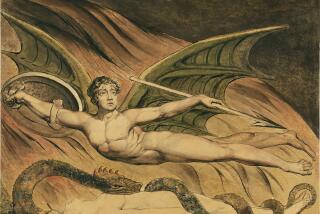Much more than the Good Book
- Share via
COLLEGEVILLE, Minn. — As Donald Jackson and his scribes worked on a handwritten and illuminated Bible, they used an image unavailable to the monks of the Middle Ages: a view of Earth taken from outer space.
It’s one of the many modern touches in the St. John’s Bible, from using computers to lay out pages to including “virtual voice prints” of chanting monks, Buddhists and American Indians in several artworks.
“It’s a work of art and spirituality for the new millennium. It’s not a 12th century Bible,” says Tim Ternes, director of public programs and education for the St. John’s Bible. “It’s very modern.”
But this Bible -- believed to be the first of its kind commissioned by a Benedictine monastery in 500 years -- is still done the old-fashioned way, with every letter and illustration painstakingly drawn by hand.
Jackson and his team of artists in Monmouth, Wales, use goose or swan quills. Inks are prepared using egg yolks as a binder. The words are written on large sheets of vellum, or calfskin, which are then embellished with gold, silver or platinum.
“People just open a page, and tears come into their eyes,” Jackson says.
The eight-year, $4-million project, funded by private donations, has reached the halfway point. About 70% of the text has been written, and 40% to 45% of the illustrations are done.
When the Bible reaches its expected completion in 2007, it will total about 1,150 pages. Each page is about 2 feet tall.
Ternes says the St. John’s Bible -- stored in a vault at St. John’s University, about 70 miles northwest of Minneapolis -- is intended for the ages. The university hopes to eventually build a building on campus to house the Bible.
St. John’s Abbey, one of the largest Benedictine monasteries in the world with about 200 monks, and St. John’s University, founded by the abbey in 1857, commissioned Jackson in 1998 to create the St. John’s Bible to celebrate the millennium and the 150th anniversary of the monks’ arrival, Ternes says.
Jackson, 66, who lettered official documents as a scribe to Queen Elizabeth’s Crown Office at the House of Lords, told Barbara Walters in a 1970 interview that he’d like to write the Bible someday. He has called it his Sistine Chapel. Eventually, Jackson asked St. John’s -- sponsor of a well-known calligraphy conference -- “Do you want this?”
The Benedictines, whose order was founded in Italy by St. Benedict about AD 530, have a long tradition of manuscript sharing and preservation. St. John’s agreed to the project, and the first words were written on Ash Wednesday 2000.
Writing the Bible is a demanding physical task, Jackson says. The most anyone can work is 5 1/2 hours a day; lettering one page takes seven to 11 hours.
The seven volumes are being done out of order but eventually will be arranged in the order of a Roman Catholic Bible. The Gospels and Acts was the first volume completed, in May 2002. The Pentateuch, the first five books of the Bible, was completed in August 2003. Psalms was finished this April, and the next volume, the Prophets, is due next February.
The New Revised Standard Version of the Bible, a modern English translation, is the text being used. Its predecessor, the Revised Standard Version, was authorized for use by Protestant, Anglican, Roman Catholic and Eastern Orthodox churches. Its language is gender-inclusive.
At St. John’s, a committee on illumination and text meets to discuss biblical interpretations. A mix of theologians and artists, the committee forwards its reflections to Jackson, who creates sketches and mock-ups of pages, which are e-mailed back to the committee.
Jackson, who was raised Methodist, and his team have created a beautiful vision that runs from Greek iconography and Jewish and Islamic symbols to startling modern images, such as a seven-panel Creation that includes a painting from a satellite view of the delta of the Ganges River.
The last image in the Gospels is a view of the universe taken from the Hubble Space Telescope. To illustrate forgiveness, the parable of the Prodigal Son incorporates an image of the twin towers of the World Trade Center.
Jackson says using an image from the Sept. 11, 2001, attacks is apt. “Everybody felt that rage on 9/11,” he says, “but ... when you read the story in the Bible, it’s telling you you can’t hate your way out of anything. You’ve got to love your way out.”
In keeping with the tradition of handwritten Bibles, the St. John’s Bible includes paintings of butterflies and flowers that team member Chris Tomlin made in the Minnesota farmland and forests around St. John’s. The St. John’s bell tower shows up a couple of times.
Pages are on display at the university’s Hill Monastic Manuscript Library. Next April, portions of the first three volumes go on exhibit at the Minneapolis Institute of Arts before starting a national tour.
A “coffee table” edition of the Gospels and Acts, a print series and a book about the making of the St. John’s Bible also are in the works.
More to Read
Sign up for our Book Club newsletter
Get the latest news, events and more from the Los Angeles Times Book Club, and help us get L.A. reading and talking.
You may occasionally receive promotional content from the Los Angeles Times.










